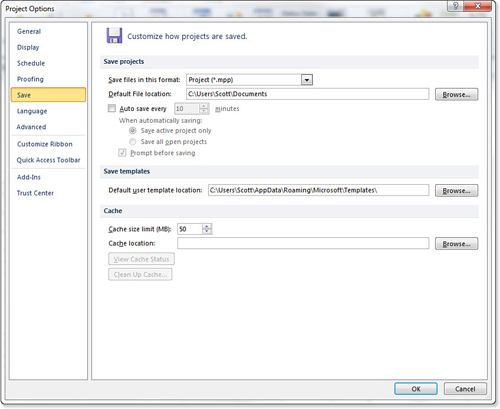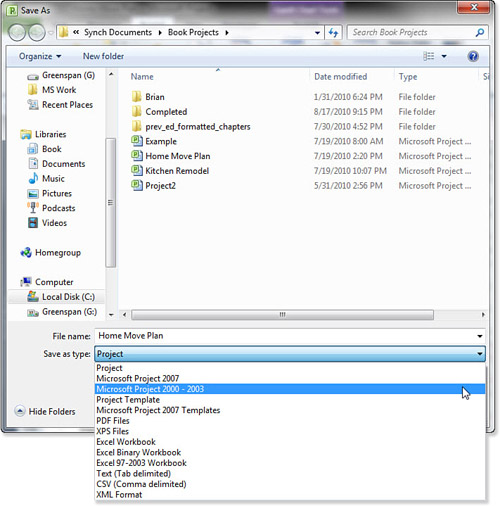When working with Microsoft Project 2010, you will
want to know how to manipulate its important files and how file
information is organized within the tool.
You can save project files in
many different formats when you are working with a group of people and
sharing your files. Some of these options include Excel document and
XML. When sharing your project file, it is important to protect the data
within it and limit the control other people have over it. You might
also create or need a custom object such as a calendar or view. The
following sections discuss the options you have when saving, protecting,
and sharing your project files.
Designating the Default Save Location and Format
When
you are using Microsoft Project and save your project, it is saved to
the default location—My Documents with the extension .mpp. However, you
can modify the default location for storing your project files, as well
as their type, by using the Project Options window. In addition, you can
also designate the default save location for the user-defined templates
that you create yourself.
Note
Previous versions of Microsoft Project also supported a location for saving templates you share with others, referred to as workgroup templates. This feature has been removed from Microsoft Project 2010. |
To change the default save location for your files, follow these steps:
1. | Open the Options dialog box by selecting the File tab, Options.
|
2. | In the Options dialog box, select the Save tab (see Figure 1).

|
3. | To
modify the default save type for the projects you create, select the
Save Files in This Format drop-down list and choose between the four
available options:
- Project(*.mpp)— The default Project file type and the recommended option.
- Microsoft Project 2007(*.mpp)— Saves the Project file to be compatible with Microsoft Office Project 2007.
- Microsoft Project 2000–2003(*.mpp)— Saves the Project file to be compatible with Microsoft Office Project 2000, 2002, or 2003.
- Template(*.mpt)— The template file type; used to designate template files within Project.
|
4. | To
modify the default location for saving regular project files or
templates, change the Default File location. Browse to the new
designated location and click OK to save your changes (refer to Figure 18.1).
Tip You
should designate a new location for your project files under the My
Documents folder on your computer. This will help you organize your
files into one central location and keep them separate from other
documents on your computer. Similarly, it is recommended to create a
User Templates folder somewhere under My Documents as well. This
designates a single location for all of your Project templates and makes
locating them much easier. If your organization has standards for
organizing your personal files on your computer, this is a great place
to integrate those standards and create additional folders to
accommodate your project and template files. If your organization is
sharing project templates, you could change the file location to the
network drive where you all share your project templates. You need to
make sure that no one changes the location of the network drive without
informing all project managers using the templates if you decide to do
this. |
|
5. | You
can also set the frequency that Project automatically saves your
project file. To do so, select the Auto Save Every check box under the
Auto Save section and then enter the number of minutes in the minutes
box. This option also enables you to select what kind of projects you
want Auto Save to apply to, as well as whether you want to be prompted
each time there is an automatic save (see Figure 18.1).
|
6. | Click OK to save your changes or click Cancel to exit without saving.
|
Version Compatibility
Microsoft Project
2010 is backward compatible, meaning you can open files that have been
created in previous versions of the tool. However, some restrictions
apply. For example, if a particular feature has been removed or modified
from a previous version, modifications to the project file regarding
that feature might not carry over into the new version. In particular,
Manual Task mode is a 2010-only feature. If you save a project file into
an earlier version, your manual tasks will all have been changed to
auto-scheduled, with unpredictable results.
Note
Microsoft
Office Project 2000, 2002, and 2003 also had the capability to save
project files to be compatible with Microsoft Project 98. However, this
hasn’t applied since Project 2007. |
Even though Microsoft
Project is backward compatible, the same theory does not work when
opening project files created in 2010 using the previous versions of the
tool. Microsoft Office Project 2000, 2002, 2003, 2007, and 2010 do
share the same file type for project files (.mpp). However, you have to
specifically save the project file from Microsoft Project to the lower
version of Microsoft Project in order for the files to be readable by
the earlier versions.
To save a Microsoft Project
2010 file to be compatible with one of the previous versions of
Microsoft Project (except Project 98), select File, Save As; in the Save
as Type drop-down box, select one of the other options, as shown in Figure 2.
